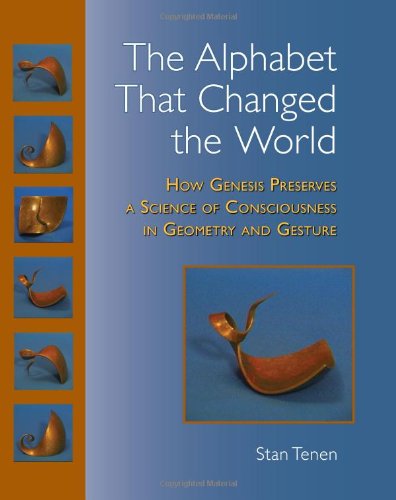Book review: The Alphabet that Changed the World
by Stan Tenen
★★★★
In the beginning God created the heaven and the earth.–Genesis 1:1
Magical words, to be sure, but perhaps we are just now uncovering how magical! Bet you never thought a research book could be written about the first verse of the Bible!
This is a deep look into the possible origins of the Hebrew alphabet, presenting its construction of letters as based on universal hand gestures, with meaning inherent in each and every letter. The Torah (the first five books of the Bible), Tenen surmises, was first written as a series of figures with no intent for them to form spoken words. The “letters” are a choreograph of manual/somatic gestures, which constituted a language in its own right. Each letter becomes intimate, in the shape of the idealized human hand seen in 2-D projection. This language, says Tenen, possibly predates the evolution of our species, as a communicative practice of higher primates! Performed properly, the hand-dance has spiritual and experiential significance, leading the performer to a personal experience of the Transcendent.
Tradition says that the Torah is a template for Creation, so let’s read the first verse of the Bible again, dancing letter-by-letter, rather than word-by-word (Tenen’s interpretation):
The primary distinction, expressed by the topological relationship between inside and outside | initiates | everything | by the expression of | a singularity | and all of its internal and external symmetries. | The primary distinction between inside and outside | reaches out into everything; | everything abstracts back to a point, | framing and/or connecting | a single choice | to the bulk–the plenum of all choices | All of the internal and external reflections (symmetries) | connecting/framing | the expression of the expansion of a single choice among all choices | and | all the internal and external reflections | connecting/framing | everything | from the initiating (principle) | endlessly.
Hmmm. As an explanation of how God created the heaven and the earth, it’s a bit disjointed, but of course the translation may not yet be perfected. But, really, now: could the ancients who wrote the Bible have possibly been this astute? Tenen finds unexpected evidence of ancient wisdom hidden in the alphabet through a myriad of mathematical models, and founded the Meru Foundation in 1983 to further explore these patterns.
What makes the book fascinating is that Tenen does not merely present his findings; he leads us on a visually pleasing journey of discovery, blind alleys and all. His story of learning how to wear the Hebrew arm tefillin, and the insight it brought, made me smile. This book is a mathematician’s playground, roaming through simple pattern matching to base-3 numbering through various topological equivalents. The Torus plays a key role. Along the way, we examine color-coded rubics cubes with Cartesian coordinates (its 3x3x3 structure accounts for the 27 letters of the Hebrew alphabet), a pictorial golden rule, and an inverted T diagram of the relation between Yahweh and Elohim. I hold a B.S. in mathematics, though I’m very rusty, so I’m glad Tenen chose to present everything in diagrams rather than stale formulas—beautiful, color diagrams, mind you—and it awakened within me that old fire to communicate through the most common of languages: mathematics. Topology enthusiasts: you’ve just found heaven.
Tenen is well aware that his hypothesis contradicts common scholarly opinion, in the development of both language and the Torah. For example, it precludes the Documentary Hypothesis, because it assumes construction of the Torah as a single unit. The Documentary Hypothesis states that the Torah contains the writings of at least four different authors or communities, carefully spliced together by a later redactor. One way scholars tell one Torah author from another is by how the writer refers to God: one calls God “Elohim,” another “Yahweh.” Tenen notes this distinction, and explains that the one creator of the Torah did this not by accident; his purpose being to conflate and highlight the two forms of God, as YH-VH (“Lord”) and Elokim (“God,” the eternal). The One and the Many. Singularity and Wholeness.
I should pause at this point to explain that The Mura Foundation is an ongoing project. This book presents a mostly unexamined hypothesis, when extended beyond its analysis of the alphabet and the first verse of the Bible. Extrapolating from the first verse to a belief that the entire Torah contains the same magic seems to me, as yet, unfounded. How and when, for example, did we begin to read the Torah in its more shallow word-by-word interpretation, leading to the stories our children learn in Sunday School? This story-telling overlay is no accident, Tenen explains; it is a means of clothing the Torah’s more intellectual/meditative message to hold the attention and gain the loyalty of a nation, so that its inner significance would be revered and preserved. How this happened, however, is not well explained. Perhaps rabbinic tradition provides the explanation, in the story of how Ezra restored the “original” form of the letters? By the time of Ezra, all the events recorded in the Torah had long since taken place, so dividing the string of the letters up into words and supplying the vowelization required for pronunciation was then possible. From then on, the fact that the “real” Torah consisted of the undivided string of letters was no longer obvious from looking at the text. Never-the-less, caution is required, for if you change the text by even “a jot or a tittle,” that is, if you add or remove even the crown on a single letter, or any other mark, the consequence would be disastrous! The hand dance would fall apart.
So do I think Tenen is on his way to discovering a key to the scriptures, through his theory of how the alphabet developed? I’m naturally skeptical. I’ve reviewed similar books before, by authors looking for a hidden code in the Bible: The Bible Code and From Adam To Noah. The first flopped horribly, while the second was much more interesting but still, in my opinion, overstated its thesis. The first was fun with word puzzles, the second fun with numbers. Tenen’s approach transcends the two, though it’s still quite fantastic.
At the very least, this is a kaleidoscopic journey deep into the mystery and beauty that is the ancient Hebrew alphabet. At most, it is a discovery that rocks the world of the Abrahamic religions, uniting them as one. For me, because I can’t so easily let go of scholarly research that reads the Torah as a spliced collection of unique writings, it’s somewhere in the middle.












 354 Circles
354 Circles
 603 Goodreads Friends & Fans
603 Goodreads Friends & Fans

 Hello! I'm an author, historical Jesus scholar, book reviewer, and liberal Christian, which means I appreciate and attempt to exercise the humanitarian teachings of Jesus without getting hung up on any particular supernatural or religious beliefs.
The Bible is a magnificent book that has inspired and spiritually fed generations for thousands of years, and each new century seems to bring a deeper understanding of life’s purpose. This is true of not only Christianity; through the years, our age-old religions are slowly transforming from superstitious rituals into humanitarian philosophies. In short, we are growing up, and I am thrilled to be riding the wave.
I avidly read all thought-provoking religion titles. New authors: I'd love to read and review your book!
Hello! I'm an author, historical Jesus scholar, book reviewer, and liberal Christian, which means I appreciate and attempt to exercise the humanitarian teachings of Jesus without getting hung up on any particular supernatural or religious beliefs.
The Bible is a magnificent book that has inspired and spiritually fed generations for thousands of years, and each new century seems to bring a deeper understanding of life’s purpose. This is true of not only Christianity; through the years, our age-old religions are slowly transforming from superstitious rituals into humanitarian philosophies. In short, we are growing up, and I am thrilled to be riding the wave.
I avidly read all thought-provoking religion titles. New authors: I'd love to read and review your book!
 Hi! While Lee writes the articles and reviews the books, I edit, organize, and maintain the blog. The views expressed here are Lee's but I'm his biggest supporter! :-)
Hi! While Lee writes the articles and reviews the books, I edit, organize, and maintain the blog. The views expressed here are Lee's but I'm his biggest supporter! :-)
Connect With Me!